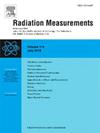Comparison of liquid radioactive waste characteristics using CeBr3, LaBr3(Ce), and NaI(Tl) scintillators for on-site applications
IF 2.2
3区 物理与天体物理
Q2 NUCLEAR SCIENCE & TECHNOLOGY
引用次数: 0
Abstract
The identification and quantification of gamma-emitting radionuclides in liquid radioactive waste are crucial for regulatory compliance and environmental safety. This study compares the detection performance of NaI(Tl), LaBr3(Ce), and CeBr3 scintillators-based detectors under identical conditions to determine their suitability for on-site gamma spectroscopy. The Minimum Detectable Activity (MDA) and activity measurement accuracy were assessed using liquid radioactive waste samples containing 137Cs and 60Co, with results benchmarked against High Purity Germanium (HPGe) detector measurements. LaBr3(Ce) exhibited superior energy resolution and the lowest MDA, making it an ideal choice for detecting low-activity samples. However, its intrinsic background radiation could affect measurement uncertainties. CeBr3 demonstrated lower intrinsic background radiation and stable detection performance, providing a balance between sensitivity and accuracy. In contrast, NaI(Tl) exhibited the highest MDA and the poorest energy resolution, limiting its suitability for precise radioisotope identification. The analysis highlights the significance of energy resolution and intrinsic background radiation in scintillator selection for on-site applications and provides essential reference data for optimizing real-time monitoring of liquid radioactive waste.
使用CeBr3、LaBr3(Ce)和NaI(Tl)闪烁体进行现场应用的液态放射性废物特性比较
液体放射性废物中伽马放射核素的鉴定和定量对于遵守法规和环境安全至关重要。本研究比较了NaI(Tl)、LaBr3(Ce)和CeBr3闪烁体探测器在相同条件下的探测性能,以确定它们对现场伽马能谱的适用性。以含137Cs和60Co的液态放射性废物样品为基准,以高纯锗(HPGe)探测器的测量结果为基准,评估了最小可检测活性(MDA)和活性测量精度。LaBr3(Ce)具有优异的能量分辨率和最低的MDA,是检测低活性样品的理想选择。然而,它的本底辐射会影响测量的不确定度。CeBr3具有较低的本底辐射和稳定的检测性能,提供了灵敏度和准确性之间的平衡。相反,NaI(Tl)表现出最高的MDA和最低的能量分辨率,限制了其精确放射性同位素鉴定的适用性。该分析突出了能量分辨率和本底辐射在现场应用闪烁体选择中的重要性,为优化放射性液体废物的实时监测提供了必要的参考数据。
本文章由计算机程序翻译,如有差异,请以英文原文为准。
求助全文
约1分钟内获得全文
求助全文
来源期刊

Radiation Measurements
工程技术-核科学技术
CiteScore
4.10
自引率
20.00%
发文量
116
审稿时长
48 days
期刊介绍:
The journal seeks to publish papers that present advances in the following areas: spontaneous and stimulated luminescence (including scintillating materials, thermoluminescence, and optically stimulated luminescence); electron spin resonance of natural and synthetic materials; the physics, design and performance of radiation measurements (including computational modelling such as electronic transport simulations); the novel basic aspects of radiation measurement in medical physics. Studies of energy-transfer phenomena, track physics and microdosimetry are also of interest to the journal.
Applications relevant to the journal, particularly where they present novel detection techniques, novel analytical approaches or novel materials, include: personal dosimetry (including dosimetric quantities, active/electronic and passive monitoring techniques for photon, neutron and charged-particle exposures); environmental dosimetry (including methodological advances and predictive models related to radon, but generally excluding local survey results of radon where the main aim is to establish the radiation risk to populations); cosmic and high-energy radiation measurements (including dosimetry, space radiation effects, and single event upsets); dosimetry-based archaeological and Quaternary dating; dosimetry-based approaches to thermochronometry; accident and retrospective dosimetry (including activation detectors), and dosimetry and measurements related to medical applications.
 求助内容:
求助内容: 应助结果提醒方式:
应助结果提醒方式:


